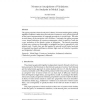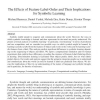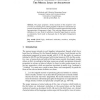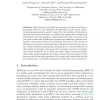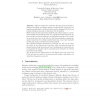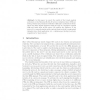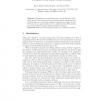104
Voted
JAPLL
2011
14 years 7 months ago
2011
The paper proposes a formal analysis of a theory of norms resulting from pulling together Anderson’s reduction, the analysis of counts-as, and a novel approach to the formal rep...
121
click to vote
MODELS
2010
Springer
14 years 11 months ago
2010
Springer
Formal analysis can be used to verify that a model of the system adheres to its requirements. As such, traditional formal analysis focuses on whether known (desired) system propert...
118
click to vote
COGSCI
2010
15 years 22 days ago
2010
Symbols enable people to organize and communicate about the world. However, the ways in which symbolic knowledge is learned and then represented in the mind are poorly understood....
94
Voted
DEON
2008
Springer
15 years 2 months ago
2008
Springer
The paper proposes a formal analysis of the ascriptive view of norms as resulting from pulling together Anderson's reductionist approach, the analysis of counts-as, and a nove...
101
Voted
ECOOP
1998
Springer
15 years 4 months ago
1998
Springer
Abstract. Inheritance is one of the key concepts in object-oriented programming. However, the usefulness of inheritance in concurrent objectoriented programming is greatly reduced ...
FM
1999
Springer
15 years 4 months ago
1999
Springer
Software architecture addresses the high level specification, design and analysis of software systems. Formal models can provide essential underpinning for architectural descripti...
127
Voted
ISSS
2000
IEEE
15 years 5 months ago
2000
IEEE
Timing and power consumption of embedded systems are state and input data dependent. Formal analysis of such dependencies leads to intervals rather than single values. These inter...
104
Voted
NORDSEC
2009
Springer
15 years 5 months ago
2009
Springer
In this paper, we report the results of the formal analysis performed on the Estonian Mobile-ID protocol (deployed since 2008), allowing citizens and permanent residents of Estonia...
107
Voted
MEMOCODE
2003
IEEE
15 years 5 months ago
2003
IEEE
System-level design methodologies for embedded HW/SW systems face several challenges: In order to be susceptible to systematic formal analysis based on state-space exploration, a ...
90
Voted
ICFEM
2004
Springer
15 years 6 months ago
2004
Springer
Abstract. We present a practical approach to a formal analysis of UMLbased models. This is achieved by an underlying formal representation in Z, which allows us to pose and dischar...
